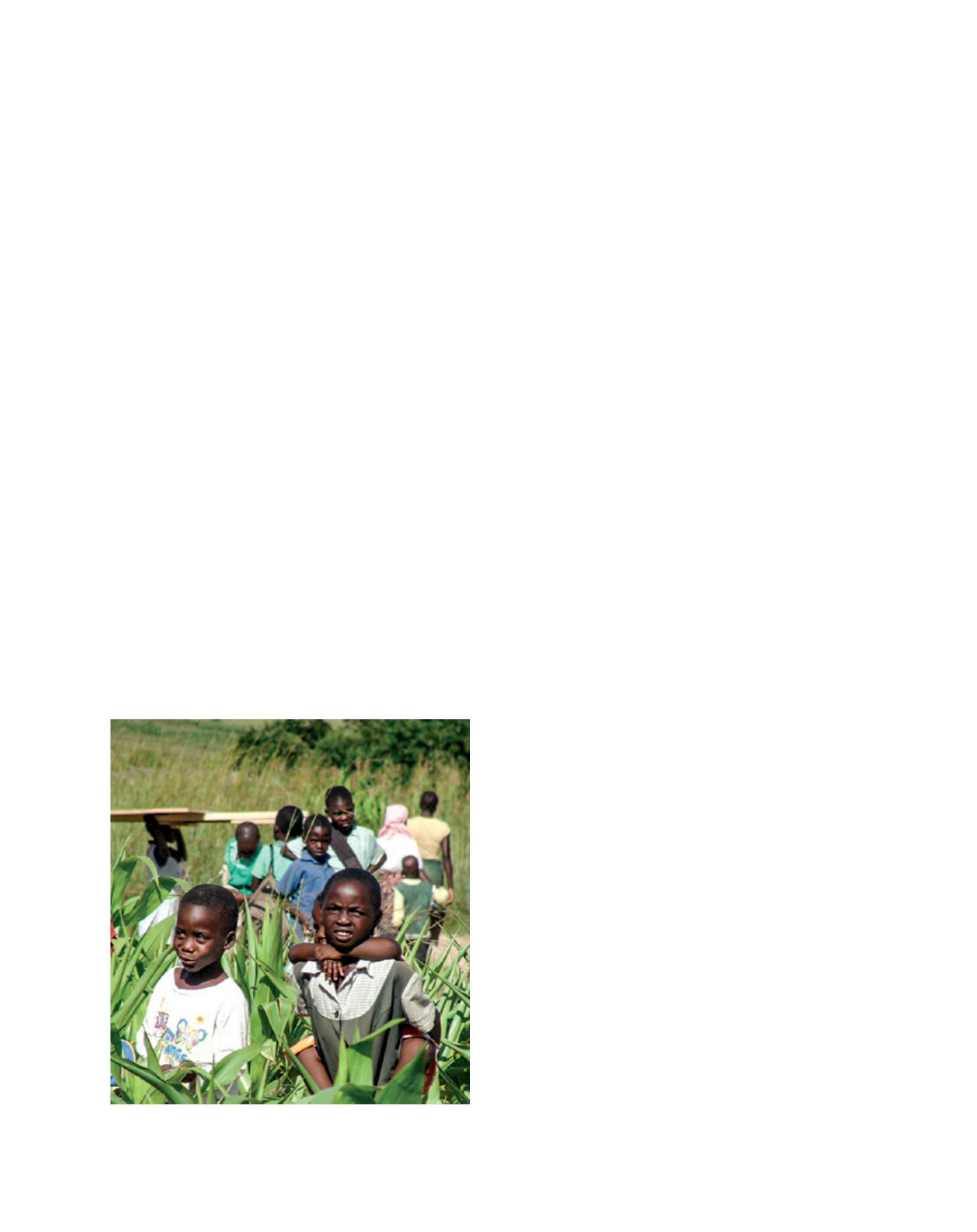

[
] 51
4.5 million unemployed youth. And when youth, particularly
young men, have few options for income, conflict can result.
The 2012 uprisings in Egypt and Tunisia were not only a
result of high prices for food and fuel, but also of the lack of
jobs and severe social inequities.
At the same time, according to the United Nations, by
2050 about 6.3 billion of a global population of more than
9.3 billion people will be living in cities. Lack of productive
land and limited rural job opportunities are ‘pushing’ young
men to look for work elsewhere. In addition, urban industries,
education and public goods are pulling people to cities, leaving
women, children and the elderly on farms. Often, they have few
resources to manage crops and are dependent on the yield from
harvest to harvest for food. But despite this move to cities, the
World Bank predicts that the majority of the population in sub-
Saharan Africa will be rural in 2030 and that some 330 million
youth will enter the job market over the next 15 years – 195
million of whom will come from rural areas.
Unfortunately, youth don’t see agriculture as a viable job
or career, but as something that lacks prestige and – more
importantly – a reliable source of income. In parts of sub-
Saharan Africa, many farmers earn less than US$2 per day.
And in the United States, farming households depend on
off-farm income for between 85 and 95 per cent of house-
hold income, according to the US Department of Agriculture.
Of countries included in the Rural Incomes Generating
Activities Database, the International Fund for Agricultural
Development found that 30-60 per cent of households depend
on at least two sources of income to make up 75 per cent of
total income. Farmers are feeding the world, but not making
enough income from farming alone to feed themselves.
Moreover, there continues to be a disconnect between
people of all ages and where their food comes from. Eaters,
young and old, have forgotten basic culinary and food
processing skills. Not only are youth not becoming farmers,
but they’re also not becoming healthy, nourished eaters.
According to the Barilla Center for Food and Nutrition, this
lack of knowledge and conviviality about food can lead to
rising youth obesity rates.
But there are solutions. They’re happening all over the
world in fields and classrooms, in kitchens and boardrooms,
and in businesses where youth are seeing tremendous oppor-
tunity in the food system, allowing them to see agriculture as
something they want to do, rather than something they feel
forced to do.
In villages outside of Kampala, Uganda, for example, the
Developing Innovations in School Cultivation project (DISC)
is helping youth build leadership skills around farming. One
of the project’s former students, Betty Nabukala, managed the
school’s garden. She explained that DISC taught the students
‘new’ methods of planting vegetables. Before, she says, “we
used to just plant seeds,” but DISC taught them how to ferti-
lize crops with manure and compost, and how to save seeds
after harvest. More importantly, Betty explained that she and
the students learned that not only can they produce food, they
can also earn money from its sale.
Students learn how to grow, process, and preserve food
and how to celebrate it through juice parties and activities
that allow them to recognize the diversity and uniqueness
of their local food cultures. In Uganda, and throughout sub-
Saharan Africa, local and indigenous foods are often looked
down upon or even thought of as weeds or poor people’s food.
But by re-learning how to cultivate and cook foods that have
long been eaten in Uganda and other countries, students are
learning to appreciate the food their parents and grandparents
ate. Often, these foods are better suited to local climates, more
nutrient dense, and more resilient – making them the foods
of the future as sub-Saharan Africa continues to battle the
impacts of malnutrition and climate change.
DISC was co-founded by Edward Mukiibi, who is now the
Vice-President of Slow Food International. Edie is 28 years
old and has been part of leading efforts around Slow Food’s
Thousand Gardens in Africa initiative, which is implement-
ing gardens in communities and schools across the continent.
“It is time to be proud of being a food producer and revive
our lost food traditions in Africa,” says Mukiibi, adding that
the Thousand Gardens initiative “is an opportunity for young
ones, like me” to strengthen ties between communities but
also within communities through the oral exchange of agri-
cultural traditions and practices. Thanks to DISC and Slow
Food, many students are no longer seeing agriculture as an
option of last resort, but something enjoyable, intellectually
stimulating and economically profitable.
And across the world in Milwaukee, Wisconsin and
Chicago, Illinois, Will Allen is teaching at-risk youth how to
grow food in urban areas. Will, a former professional basket-
ball player, founded the organization Growing Power to train
young people and community members “to become commu-
nity farmers” so they can have access to fresh, safe, affordable
and nutritious food at all times. In Chicago in 2013, Growing
Power’s Iron Street Farm trained more than 300 youth how
to build gardens and greenhouses, build soil, grow vegetables,
All over the world youth are seeing opportunity in the food system,
and seeing agriculture as something they want to do
Image: Bernard Pollack
D
eep
R
oots
















